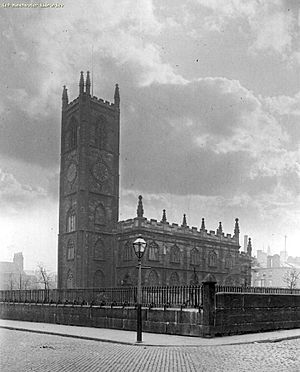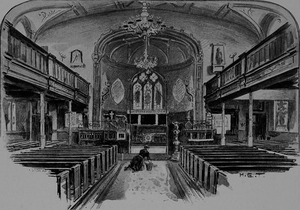St John's Church, Manchester facts for kids
St John's Church, Manchester, also known as St John's, Deansgate, was an Anglican church in Manchester, England. It was built in 1769 and taken down in 1931. Today, the area where it stood is a garden called St John's Gardens.
The church was built by Edward Byrom in 1769. He was one of the people who started the first bank in Manchester. The church's area, called its parish, covered a large and important part of Manchester. The first leader, called a rector, was John Clowes. He was the rector for 62 years until 1831. John Clowes gave the first Sunday school sermon in Manchester. He also helped introduce Swedenborgianism there and supported Whit Walks.
After Clowes, William Huntington became the rector. He had been a curate (a church assistant) since 1826. Huntington started the Sunday school, laying its first stone in 1827. In 1906, about 250 children went to the Sunday school. The church also had groups like a Penny Bank and a Choral Society.
By the early 1900s, the churchyard was in the shadow of a large warehouse. Fewer people were attending the church. Also, there was another church nearby, St Matthew's Church. So, the Manchester diocese decided to combine St John's parish with St Matthew's in 1927. Because of this, St John's Church was taken down in 1931.
St John's Church was one of the first important buildings in Manchester built in the Gothic Revival style. This style looks like old medieval churches. Its tower had eight bells made by Lester and Pack. The church was repaired several times, in 1821, between 1874 and 1878, and in 1898. The bells were said to be "among the best" in Manchester. The roof fell in 1924 but was rebuilt by 1926. Some church windows honored people like John Owens and Sir Thomas Bazley.
Today, a stone cross and a plaque mark the church's graveyard. The plaque says that over 22,000 people are buried there. Famous people buried in the churchyard include John Owens, who started Owens College (which became part of Manchester University), and William Marsden, who first thought of having a half-day holiday on Saturdays.
Contents
Why St John's Church Was Built
Manchester's population grew very fast in the mid-1700s. This meant more churches were needed. Edward Byrom (1724–1773) built St John's Church in 1769. He was a co-founder of Manchester's first bank. His family was well-known and wealthy in the area.
A local historian, William Shaw, said the church was "intended for the 'genteel' residents." These were the richer people moving to the south side of town.
Edward Byrom got permission from Edmund Keene, the Bishop of Chester. Many important local people supported him. The church's parish covered a large and important part of Manchester. It stretched from Quay Street and Brazennose Street in the north to the Central Station and Bridgewater Street in the south. Its eastern border was the Town Hall and Cooper Street, and its western border was the River Irwell.
In 1831, the famous artist J. M. W. Turner sketched the tower of St John's Church. This sketch is now in the Tate art collection.
Church Design and Changes
Edward Byrom paid for the church, but the architect's name is not known. The historian Clare Hartwell said it was the first important building in Manchester built in the Gothic Revival style. It had galleries inside, supported by thin cast-iron columns.
Edward Byrom laid the first stone on April 28, 1768. Bishop Keene officially opened the church on July 7, 1769. The tower, with its eight bells, was finished in May 1770.
The church was first repaired in 1821. Edward Byrom's daughter paid for a new roof. More work was done between 1874 and 1878. In 1898, the lighting changed from gas to electric. The church bells were rehung in 1832 and again around 1883. The tower had clock faces on all four sides. A minute hand was added to the clock in 1833. The graveyard was paved with tombstones.
In 1924, the church roof fell down. It was rebuilt by 1926. Some church windows honored important people like John Owens and Sir Thomas Bazley. One old window came from a convent in France. It was moved to the Church of St Mary the Virgin, Eccles in 1929. Other windows were moved to St Ann's Church.
What the Church Was Used For
St John's Church had the right to perform marriages for people from all over Manchester until 1874. For the first 35 years, there were no weddings there. This was probably because another church, the Collegiate Church, charged extra fees for weddings held at St John's. This made it twice as expensive. Later, after the Collegiate Church's rules changed, more than 100 weddings happened at St John's some weeks before 1874.
Burials in the churchyard stopped completely in 1900. There had been very few for years before that because the space was full.
In 1827, the church built a special building for its Sunday school. This building was also used as a day school from 1838. In 1906, about 250 children went to the Sunday school. The church also had many groups, like a Penny Bank and a Choral Society.
In 1906, Hannah Mitchell, a suffragette (a woman who fought for the right to vote), was arrested at the day school. She was protesting during an election speech by Winston Churchill. The school building closed in 1908. A new school opened in 1910, but it was only used for Sunday school. The church said this was because of too many rules from the Board of Education.
Around 1781, the church was home to one of Manchester's eight fire engines.
Church Leaders
Edward Byrom made a rule that he could choose the church's leader. The first rector, John Clowes, was in charge for 62 years until he died in 1831. Two stone tablets in the church honored him. One was by Richard Westmacott or his son. The other, by John Flaxman, celebrated his 50th year as rector. Clowes gave the first Sunday school sermon in Manchester. He also brought Swedenborgianism to the area and supported Whit Walks.
William Huntington took over from Clowes. He had been a curate since 1826. Huntington started the Sunday school. After Huntington, John Henn was rector for 14 years. Then came G. R. Youngman, who died in 1890. E. F. Leach took his place. The last rector was Herbert Edmonds.
William Cowherd, who believed in Swedenborgianism and supported teetotalism (not drinking alcohol) and vegetarianism, was a curate in the late 1700s. He later started the Bible Christian Church in Salford.
Why the Church Was Taken Down
By the early 1900s, a warehouse on Quay Street overshadowed the churchyard. This warehouse was built where the Byrom family used to live. The area around the church used to be residential, with rich families living there. Richard Cobden was one famous person who lived nearby and went to the church. But during the 1800s, the area changed. Many homes became lodging houses, and it became more of a business area. The people who lived there or were in nearby hospitals were often poor. They could not give much money to the church or its schools.
Fewer people came to church because the area became more about business. Also, there was another church nearby, St Matthew's Church. So, the Manchester diocese looked at what to do with St John's in the 1920s. After looking into it, they decided in 1927 to combine the two parishes into St Matthew's parish. The diocese chose to keep St Matthew's and take down St John's. This was partly because St Matthew's was a newer building.
In 1929, the Ecclesiastical Commissioners suggested giving the church site to Manchester Corporation. They hoped the city would turn it into an open space, like Parsonage Gardens. The Manchester Guardian newspaper had reported a similar idea in 1914.
St John's Church was taken down in 1931. A stone cross and a plaque now remember it. The plaque says that over 22,000 bodies are buried in the area. These include John Owens, who started Owens College, and William Marsden, who helped create the idea of a half-day holiday on Saturdays.



